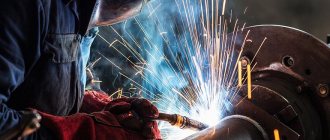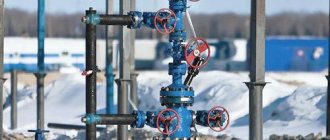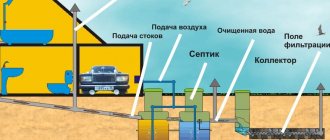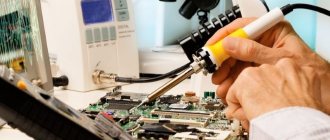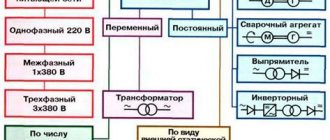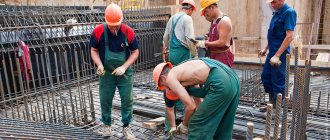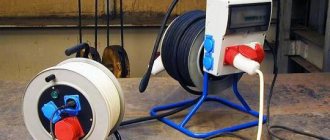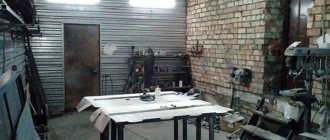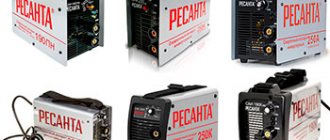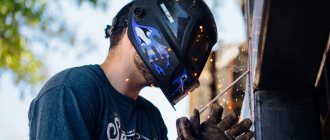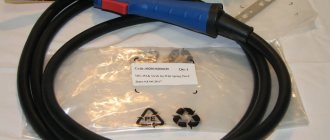Welding process
Welding technological process : design principles
Design of a welding technological process is a complex optimization problem based on the use of computational analytical design methods. The optimal technological process for manufacturing a complex welded structure is selected from several design technology options. Depending on the main purpose, promising and operational technological processes are distinguished.
Layout of the assembly and welding area
| 7. According to GOST 2.002-72, the following colors are used when planning areas (shops): – red: overhead track, crane beams, bridge beams, cranes, consoles; — blue: sanitary-technological equipment (air ducts, pipelines); — pink: energy equipment and routes; — light green: technological equipment for metallurgical processing and repair and technological enterprises; — orange: equipment for the chemical and petrochemical industries; -blue: cargo flow. 4.2 Calculation of span width1 – place for hydrotesting; 2 – storage space; 3 – workplace; 4 – gas cutting machine Figure 4.1 – Span width diagram Let's calculate the span width of the section using the formula: , (4.1) where Bpr – span width, [m]; b1 – distance from the back of the equipment to a column or wall, [m]; bM – width of the workplace, [m]; b2 – distance between working and storage places, [m]: bsk – width of the storage space, [m]; bп – passage width, [m]. m. We assume a span width of 24 m. 4.3 Calculation of section lengthFigure 4.2 shows a diagram of the length of the section. Figure 4.2 – Section length diagram The length of the section consists of the sequential sum of the sizes of workplaces and passages between them. The sizes of workplaces are selected depending on the size of the product being manufactured. The passages between workplaces are taken from 1.5 to 3 m. Since the building is a one-story building, the column pitch is 12 m long. Depending on the column pitch, the size of workplaces and passages, the length of the section in the project will be 60 m. 4.4 Calculation of span heightThe span height of the section (see Figure 4.3) from the floor to the level of the surface of the rail head of the crane tracks is determined by the formula: , (4.2) where Hп is the height of the span of the section from the floor to the level of the surface of the rail head of the crane tracks, [m]; h2 – the highest height of the production equipment in the span under consideration, [m]; h3 is the distance between the highest point of the equipment and the lowest point of the protruding structural parts of the floor (the value of this size is usually 0.4...1 m). h4 – distance from the surface level of the crane track rail head to the lowest point of the lifting hook in its highest position, [m], we take 2.25 m. m. Figure 4.3 – Diagram of the span height of the section The span height of the section from the floor to the lower level of the ceiling rafters is determined by the formula: , (4.3) where Hз is the height of the span of the section from the floor to the lower level of the ceiling rafters, [m]; h5 – distance from the surface level of the crane track rail head to the highest point of the overhead crane trolley equipment, [m], (take 1.65 m); h5 – the distance between the highest point of the crane trolley equipment and the lower level of tightening of the floor rafters, [m], (taken 1 m). m. vunivere.ru |
welding process
includes :
- sequence of technological operations;
- breakdown of the structure into individual technological units or elements;
- preliminary design of special devices and equipment;
- calculations of the modes of basic welding processes, calculations of expected welding stresses and deformations;
- comparative assessment of developed technology options.
After the final approval of the technical design and the accepted technology option, detailed design of the structure (drawing up design documentation) and development of working technology (drawing up technological documentation) are carried out.
The working welding process includes:
- clarifications and changes in the fundamental technological process associated with design changes at the detailed design stage;
- development of technological maps, which indicate all the parameters of the welding mode, the welding materials and equipment used;
- brief descriptions of technological methods for performing individual welding operations;
- requirements for the strength and quality of welded structures at individual stages of their manufacture;
- instructions on methods for checking the accuracy and quality control of connections, assemblies and finished structures.
Depending on the number of products covered by the process, two types of technological process have been established: standard and single. The rules for the development of working technological processes provide for the mandatory use of standard technological processes and standards for technological operations.
Depending on the degree of detail, each welding process can be route, operational or operational-route. Standard technological processes are developed based on an analysis of many existing and possible technological processes for typical representatives of product groups. A technological operation is part of a technological process, carried out at one workplace.
Welding process: development of a standard welding process
The main stages of development of a standard technological process include:
1) classification of production objects - select groups of objects that have common design and technological characteristics, and typical representatives of the groups;
2) quantitative assessment of groups of objects - assessment of the type of production (single, serial or mass);
3) analysis of the designs of standard objects according to drawings, technical specifications (TS), production programs and type of production; develop the main routes for the manufacture of structures, including procurement processes;
4) selection of a workpiece and methods of its manufacture with a technical and economic assessment, assessing the accuracy characteristics of manufacturing methods and surface quality, choosing a processing method;
5) selection of technological bases;
6) choice of type of production (welding, casting, pressure treatment, machining);
7) drawing up a technological processing route - determine the sequence of operations and select groups of equipment for operations;
 development of technological operations, including:
development of technological operations, including:
- rational construction of operations;
- choosing the structure of operations;
- rational sequence of transitions in operations;
- selection of equipment that provides optimal performance and required quality;
- calculation of loading of technological equipment;
- choice of design of technological equipment;
- determining whether the selected design belongs to standard equipment systems;
- establishing the initial data necessary for calculations and calculating processing allowances and interoperational allowances;
- establishing initial data for calculating optimal processing modes and their calculations;
- establishing initial data for calculating time standards and their calculation;
- determination of the category of work and profession of performers;
9) calculation of accuracy, productivity and economic efficiency of standard technological process options with the selection of the optimal option;
1O) preparation of documentation for a standard welding technological process, its coordination with the interested services and approval.
The enterprise must have computer information retrieval systems to search for previously developed similar technological processes and individual technological operations.
All information is entered into the computer in encoded form. When developing a technological process, the manufacturability of welded products and structures is analyzed. Quantitative assessment of manufacturability is based on a system of indicators, including:
- basic indicators of manufacturability established in the technical specifications for product design;
- manufacturability indicators achieved during design development;
- level of manufacturability (ratio of achieved indicators to basic ones).
The main indicators of manufacturability are the labor intensity and technological cost of manufacturing a product.
Factors influencing the choice of indicators: requirements for the product, type of product, production volume, availability of information necessary to determine the indicators.
Requirements for a product determine what type of manufacturability the design should have: production, operational, or both, which, in turn, determines a group of manufacturability indicators.
Depending on the type of product (assembly unit, complex, kit or part), those indicators that can characterize the manufacturability of this type of product are selected from the groups.
Knowing the volume of output allows you to select indicators that characterize costs or expenses and are of the greatest importance for a given volume of output.
Topic 2 Typical diagrams of assembly and welding shops
The location of the workshop and all its production departments and sections, as well as auxiliary, administrative, office and service premises, should, as far as possible, fully satisfy all the specific requirements of the processes to be performed in each of these departments. This is one of the main tasks of rational design of industrial enterprises.
This topic addresses issues of efficient use of production space, transportation of component parts and welded structures.
When studying the material, pay attention to the fact that in welding shops the main leading processes are assembly and welding work; therefore, special attention should be paid to meeting the requirements of these processes in the first place when developing welding production projects.
Students should learn:
— diagram of the workshop with the longitudinal direction of the production flow;
— diagram of a workshop for the production of complex structures of the same type;
— a workshop diagram with a loop direction of the production flow;
— diagram of a workshop with a mixed direction of production flow.
Literature: [1, p. 174-181]
Questions for self-control
1 What is one of the main tasks of rational design of industrial enterprises?
2 List the main layout diagrams of assembly and welding shops
3 What does the development of a workshop technological plan include?
Topic 3 Development of a plan and section of the assembly shop building and
Welding
When developing the plan and sections of the building of the designed assembly and welding shop, the required dimensions of the latter and the location of all the necessary production elements in it are established. In this case, determining the required height of the workshop building does not present any difficulties, since the maximum dimensions of the products to be manufactured and the adopted production equipment are known. Consequently, the main and rather complex task of the described design development is the preparation of a workshop plan, which ultimately represents one of the most important results of the entire workshop design process. Such a plan of a workshop (department, section), which determines the spatial location of the production process in it, is called technological, in contrast to the construction plan, which is subsequently developed by builders in order to identify the design features and details of the workshop building.
The development of a technological plan for a workshop includes the selection of the most rational layout of its layout, determination of its geometric dimensions and subsequent detailing of its contents.
Drawing up a plan for the workshop as a whole and each of its departments is a technical problem that allows for several solutions. A rational solution to this problem is achieved through the parallel development of several (two or three) options for the layout diagram of the workshop technological plan and subsequent technical and economic comparison of them with each other.
Students, when considering this topic, must study the equipment of assembly and welding shops, its dimensions, must learn to make calculations, calculate the required area of the sections and the height of the workshop building. It is also necessary to pay attention to the issues of labor safety and fire safety when planning the workshop and arranging equipment.
Literature: [1, p. 181-184]
Questions for self-control
1 What does the development of a workshop technological plan include?
2 What plan is called technological?
3 What is included in the assembly and welding shop equipment?
Topic 4 Layout of the procurement area
The procurement department of the assembly and welding shop is usually located in longitudinal spans. The only exceptions are individual machines for primary metal processing, often installed in the transverse span of a metal workshop warehouse. In this case, the longitudinal spans of the procurement department either serve as a continuation of the longitudinal spans of the assembly and welding departments, or are located parallel to these spans.
This topic involves students studying equipment for mechanical and fire processing of metal at the procurement site, as well as the arrangement of equipment.
It is necessary to pay attention to the issues of labor safety and fire safety when planning the procurement site.
Literature: [1, p. 118-119; 215-216]
Questions for self-control
1 What areas are included in the procurement department?
2 What applies to equipment for mechanical and fire processing of metal at the procurement site
3 Safety precautions and fire prevention measures at the procurement site
Topic 5 Calculation and layout of storage spaces and premises
Each enterprise in the mechanical engineering industry usually has the following storage facilities:
— metal warehouses;
— warehouses for semi-finished products (intermediate, sorting);
— finished product warehouses;
— warehouses and storerooms for tools and accessories;
— warehouse for purchased parts and semi-finished products;
— warehouses for backup equipment and spare parts;
— warehouses and warehouses for cleaning, lubricating and painting materials;
— fuel warehouses.
The first four groups of storage facilities listed above at machine-building plants often have the character of decentralized workshop warehouses, while the last four groups are always of a general plant nature, i.e. are intended for simultaneous servicing of all workshops of the plant.
While studying this topic, pay attention to the types of storage areas and premises, give an example of calculating their area depending on the production program and dimensions of products, the stock of materials and the type of storage for storage. It is also necessary to pay attention to the issue of taking measures to ensure fire safety.
Literature: [1, p. 226-233]
Questions for self-control
1 Where is the metal warehouse usually located and what is its purpose?
2 What is the purpose of the finished goods warehouse?
3 What factors determine the stock of materials for storage in the workshop warehouse?
Topic 6 Calculation and planning of administrative and household facilities
Labor organization at the welding site
Welding work is intended to eliminate cracks, ruptures, breakages, as well as attaching brackets, corners, etc. Electric arc and gas welding are used in ATP. Gas welding work is usually divided into welding of thick-sheet steel parts and welding of thin-sheet steel bodies, as well as thin-walled parts. Electric welding is used to repair massive parts (frame).
Preparing metal (parts) for welding.
The metal used for the manufacture of welded structures is pre-cleaned and straightened.
Cleaning must be done before assembly. At the welding site, the edges are thoroughly cleaned of rust, oil, moisture, scale, and contaminants, the presence of which leads to the formation of pores and other defects. Particular attention should be paid to cleaning in the gap between the edges. If dirt gets into the gap of an already assembled assembly, it should be thoroughly blown out with compressed air or burned with a torch flame.
Cleaning is carried out using manual and mechanical wire brushes, the flame of a multi-torch burner, abrasive wheels, etching in solutions of acids and alkalis, and washing with solvents.
Before welding, the edges of the parts, if provided for in the drawings, are trimmed, beveled and cleaned.
To ensure high-quality penetration and formation of a weld, edges are prepared for welding. The elements of the geometric shape of preparing edges for welding are: cutting angle of the edges, bevel angle of one edge, gap between the joining edges and bluntness. Existing methods of manual arc welding make it possible to weld metal of limited thickness - up to 6 mm - without cutting edges. Therefore, when welding metal of large thickness, it is necessary to cut the edges so that the welding arc can penetrate deep into the joint and completely melt the edges through the entire thickness.
Assembling parts for welding
More than 30% of the total labor intensity of manufacturing welded parts and assemblies is made up of labor costs for assembling parts for welding.
The assembly of parts for welding is carried out in order to establish the relative spatial position of the elements of welded structures. To reduce assembly time, as well as increase its accuracy, various devices are used: installation parts, clamping mechanisms, stands, jigs, etc.
Assembly of parts for welding is carried out in several ways. The most rational method is sectional assembly, which involves assembling and welding the individual components that make up the structure, and then assembling and welding the entire structure.
Welding shop equipment
Equipping a welding workshop with the necessary equipment will not be difficult for a person who knows the specifics of this field of activity. A beginner will have a more difficult time making a choice. Therefore, it is worth acting consistently. First, you need to determine the list of work carried out in the workshop and make a list of the equipment and furniture that are needed for this. Next, you need to decide on a budget. Then choose the best options in terms of price and quality. To open a welding workshop you will need:
- welders
- welding tables
- metal working tools
- generators
- protective equipment
The cheapest equipment is Chinese-made. However, it will be significantly inferior in quality to European units. Russian equipment is average in quality and price. It is not necessary to purchase new devices; you can buy used ones, and over time, as your business expands, buy newer and more advanced models.
The welding machine is the main tool in the workshop. It allows you to connect and separate metal parts. Based on the principle of operation, ease of use and functionality, welding machines are divided into several types: transformers, rectifiers, semi-automatic machines, inverters, argon units, devices for spot welding and installations for plasma welding. The welding table serves to ensure the convenience and safety of the work of the master. Generators are necessary to maintain the work process in case of power supply problems. Tools for metal processing (for example, a drill, metal shears, a grinder, etc.) will be needed to perform auxiliary work. Protective equipment - overalls, shields, masks, canvas gloves, balaclavas, etc. - are needed to ensure the safety of welders during work.
Organization of work of the welding shop
Any welding shop is a complex facility. To organize it, you will have to coordinate with the fire department and the sanitary and epidemiological station, because first of all, energy will be present here in pure open form, and this is electricity or fire from a gas burner.
Secondly, for the same reasons, there will be difficult working conditions here. Therefore, it is very important to study the rules of workshop organization and strictly observe them during the entire life of the welding area.
Where to begin
The design of welding shops is of paramount importance.
What is it? There are several positions here that will determine the technological process regarding welding work, as well as the assembly of components and parts. First of all, you need to sort out the equipment. It is clear that the main equipment for a welding shop is welding machines (gas, electric). Their cost is determined by the volume of work performed.
If the volumes are large, then it is better to purchase professional devices. If the welding shop is small, then you can get by with household analogues. A welding shop needs to be diverse to accommodate as much work as possible, so it's worth considering purchasing a resistance welder.
We must not forget about seemingly simple devices that will occupy a certain place in the welding shop. For example, a workbench or a welding table.
It must be properly organized not only in terms of the convenience of welding operations, but also in terms of quick access to additional tools and consumables. Moreover, a welder’s workplace is a single set of devices that are used daily.
Local ventilation of the welding station
The essence of the local ventilation system is to purify the air directly at the welder’s workplace, since at a distance of already 4 m the air masses in the workshop can meet the required sanitary standards. But directly near the welding machine, chemical combinations harmful to human health accumulate in the air masses, exceeding the norm by more than 10 times.
Types of local ventilation
Flexible air intakes
- Exhaust devices of lift-and-turn type. This ventilation system consists of an air inlet, which is fixed in any position using hinges, a hose with a diameter of 200 mm connecting the air inlet and a centralized exhaust system. This design allows you to eliminate up to 85% of substances harmful to health, since it can be placed in close proximity to the welding machine. Lift-and-swivel hoods contribute to complete air purification at a distance of up to 8 m from the installation site. The most popular lift-and-turn exhaust systems are the Lan and Sprut models.
- Local suction, which are installed at a height of 1.5 m from the workplace. Another option for installing suction units is to install them directly into welding tables. They are connected to the general ventilation of the workshop with special hoses.
To ensure proper air exchange, the welding shop is equipped with forced-air ventilation. The system must provide an influx of fresh air masses of more than 40 m3/hour.
Supply ducts with fans are installed at a height of up to 4 meters. Exhaust ducts are equipped with fans of similar power and are installed on the opposite wall. The height of the channels must be the same.
Welding work is accompanied by the release of large amounts of harmful substances. To remove them, an air exchange system is required. Ventilation in a welding shop is a complex system regulated by numerous rules, which are set out in special standards and regulations.
The welding shop is a room in which the presence of a ventilation system is critically important. Despite the complexity, the availability of general information on the operation and arrangement of air exchange allows you to equip such a system with your own hands.
Location of equipment and fixtures
The equipment layout is strictly regulated by safety standards and regulations in welding shops. The layout determines safety, ease of movement of personnel, movement of parts, assemblies and finished products. There are several recommendations for arrangement:
- if a transformer is used in the workshop for electric welding, then it should be installed 5-7 m from the workbench and half a meter from the wall (minimum). The household inverter can be installed on a table surface;
- if welding is performed with gas, then cylinders with oxygen and acetylene are placed away from each other at a distance of at least 5 m. The same applies to propane equipment. The same distance is maintained between the welding site and the cylinders;
- gas hoses and electrical cables are laid away from passages so that they are not walked on. This is primarily a safety requirement, and secondly a way to preserve property;
- a distance of 1 m is left between equipment, tables, cabinets and other bulky objects for the convenience of moving people and transporting parts on carts.
Automatic welding equipment requires more space. It is necessary to take into account its movement around the welding shop and the access of performers to it.
Ventilation system
Ventilation of the welding shop is the most important component and one of the main requirements for organizing welding shops. With its help, heavy gases from the melting of metals and combustion of electrode rod coatings are removed from the welder’s workplace.
Many people make the mistake of installing a probe above a large workbench, which is connected to the general ventilation system by pipes or corrugations. The optimal and effective option is to install a side gas outlet so that they do not rise above the level of the workpieces being welded.
It is very important to make an accurate calculation of the ventilation system to ensure maximum air extraction from each workplace. It is better to install the fan outside the workshop. This will be especially true if the welding shop is organized in a garage.
A small room without ventilation will become a place where it will be impossible to stay without a respirator or gas mask. And the SES will not give permission to operate such a poorly equipped workshop. Therefore, it is very important not only to install a ventilation system, but also to correctly calculate the characteristics of the fan, especially the power of the device .
Plus, distribute the air ducts correctly so that they do not interfere when moving large parts. This means that you will have to make a drawing with the condition of the correct arrangement of all elements of the system.
Local ventilation of the welding station
The essence of the local ventilation system is to purify the air directly at the welder’s workplace, since at a distance of already 4 m the air masses in the workshop can meet the required sanitary standards. But directly near the welding machine, chemical combinations harmful to human health accumulate in the air masses, exceeding the norm by more than 10 times.
Types of local ventilation
To ensure proper air exchange, the welding shop is equipped with forced-air ventilation. The system must provide an influx of fresh air masses of more than 40 m3/hour.
Now let's take a closer look at the design features of these circuits.
The welding shop is considered, perhaps, one of the most unfavorable places for human work due to the fact that during the technological process a huge amount of harmful substances is released. Welding work provokes the saturation of the surrounding air with fluoride compounds, ozone oxides, nitrogen oxides and carbon oxides, which provoke the development of dangerous (so-called “occupational”) diseases and are harmful to the environment. That is why a well-designed and balanced welding shop ventilation system is a priority.
Structural elements
It is very important to approach the structure of the assembly and welding shop correctly. This is a manufacturing facility in which various operations are carried out using a wide range of different materials.
In addition to the main workshop, the production structure should include storage facilities: for metal, for consumables.
In the procurement department, the metal is prepared for work: cutting to specified dimensions, cleaning, grinding, etc. Next, the products are delivered to an intermediate warehouse, where blanks are assembled by item.
Then comes the main workshop, where parts and components are assembled and welded into a single structure. The last department in the structure is the finished products warehouse.
For obvious reasons, this cannot be organized in small welding shops, but this is not necessary. For example, an intermediate warehouse is of no use here, the same applies to the procurement workshop.
As practice shows, all operations are usually carried out in one room. And the finished products are either stored outside under a canopy, or delivered right there to the customer’s hands.
Description of the structure with warehouses - a fairly large complex that can be located under one roof or in different buildings. In such conditions, it is impossible to do without a well-thought-out organization of logistics that allows you to save on vehicles.
In new industries, they try to arrange welding shops on a block or modular basis. The entire structural chain is located in line with the necessary sequence of movement, from raw materials to finished products.
The attitude of consumers towards welding shops is almost unambiguous - it is a dusty room in which people work in soiled overalls. But you shouldn’t think this way about all workshops.
The new requirements and rules represent a new approach to the competent organization of work, where, first of all, the emphasis is on the person, on his professionalism, on the conditions in which he works. The result largely depends on this.
Welding shop premises
When drawing up a plan for starting a business, you should first of all take into account the requirements for premises in which electric welding work is carried out, established at the legislative level. Several workplaces (posts) can be located in one room at the same time, provided that they are separated from each other. Moreover, if electric welding work will be carried out systematically, then the posts should be placed in separate cabins, the walls of which are made of fireproof materials. If manual arc welding will be performed, and this process will be unsystematic, then screens with a height of at least 1.8 m made of non-combustible materials can be installed between the posts.
The room must have a good exchange ventilation system. Ventilation removal of gases and fresh air supply must be provided at all workplaces. The area of a separate area intended for an electric welding installation must be at least 10 square meters. m, of which at least 3 sq. m must be free from equipment and materials. In addition, in order to ensure safety and convenience of work, it is necessary to provide passages with a width of at least 0.8 m. The workshop floor must be made of non-combustible materials. It will be necessary to equip a fire shield and place primary fire extinguishing equipment on it.
Note: it is better to entrust the design of the power supply system to specialists. To create an optimal low-voltage power supply scheme for a workshop, you need to take into account the layout of the equipment, the power of electrical receivers, and calculate the power load.
An electric welding transformer and an input power supply panel must be installed in the workshop. It should be possible to connect each welding machine to a separate switch with a wire of the appropriate cross-section. The housing of any power source and the housing of the welding installations themselves should be reliably grounded. The equipment must be protected by fuses on the supply side. When choosing a room for a welding workshop, it is advisable to contact representatives of the fire inspection service for clarification regarding fire safety requirements. Work cannot begin until the workshop is completely satisfactory, which, by the way, needs to be confirmed.
Technological process of modern welding
Welding is used quite widely both for commercial and production purposes, and for performing minor repairs in a private building or in a country house. Equipment and consumables for welding work are offered to consumers in specialized stores and are affordable. The process of making a welded joint depends on the type of welding. But arc welding has become most widespread. This is what is most often used in everyday life. But the quality and reliability of the welded joint, as well as the safety of the worker himself, depend on the correct execution of the welding process.
Electrode welding process.
Price policy
The cost of welding work is calculated separately in each case and depends on:
- type of equipment required
- amount of work
- speed of order fulfillment (urgency)
The average price for basic services is shown in the table:
| Name of service | Price |
| Welding steel water pipes | 150 RUR/joint |
| Welding metal parts | 20 rub./cm |
| Making a steel fence | 800 rub./sq. m |
| Production and installation of decorative grilles | 2000 rub./sq. m |
| Manufacturing of heating registers | 800 rub./linear meter |
If the work is not carried out in the workshop itself, but on the customer’s premises, then the specialist’s visit to the site is paid separately.
Preparation and equipment
In order to make a weld using manual arc welding, you need to prepare consumables and a welding mask. The voltage in the electrical network must correspond to the nominal values required for normal operation of the welding equipment. If there are other units whose operation is not necessary, then it is advisable not to use them in the arc welding process. It is applicable for household use of arc welding. In production, electrical networks are carried out with a load reserve, so the operation of welding equipment during the arc welding process will not cause undesirable consequences.
Weld classification scheme.
In addition, the following must be available:
- A welding machine, which consists of a rheostat, a holder, and a grounding cable.
A rheostat, which provides the ability to change the supplied current. This parameter must correspond to the type of steel from which the metal parts to be welded are made. The amount of current supplied should depend on how deep the weld pool should be, what the cut seam will be, the degree of contraction, and deposition methods.
The cable used for such a connection can consist of 1, 2, 3 cores. The main thing is that the cable is designed for the expected loads, and with a margin. Otherwise, it may be damaged directly during the welding process. The grounding cable is necessary so that when the electrode comes into contact with the surface to be welded, the circuit is closed, thereby forming an arc for welding work.
General characteristics of the weldability of materials.
Such materials include several electrodes. Their number is determined by the size of the welded seam. Depending on the type and composition of the steel from which the parts to be welded are made, the type of electrode is selected. The composition of the electrode coating, proper storage conditions and other requirements that the manufacturer imposes on the consumer must be indicated on the packaging. The user needs to familiarize himself with them and strictly follow the requirements, which will ensure good performance of this consumable.
- Wire for welding.
The grade of wire and the chemical components that are inside it are also determined by the material from which the welding elements are made. All designations and areas of use of the wire must be indicated by the manufacturer on the packaging. This consumable must exactly match the grade of steel, otherwise the welded joint will be weak or impossible to make.
- If the welding process requires the use of flux, then the mixture must fully protect the working space being welded.
Some types of fluxes can only be used for specific work, if the elements for welding have a complex composition and special requirements for the quality of the resulting joint.
- When welding under special conditions or on certain metals, gas may be required.
Argon, helium and their mixtures, without affecting the chemical composition of the weld joint, nevertheless limit the access of oxygen to the working area.
Some features
The principle of gas welding.
When performing welding work, it is necessary to comply with safety requirements, thanks to which the welder is protected from the harmful effects of metal splashes and eye burns. Such protection can be provided by a welder’s mask, which is sold in specialized stores. Special glass, which is placed in the mask, reliably protects the eyes. Care must be taken to ensure that it is not damaged or scratched.
Any damage to the glass may burn the welder's cornea or may temporarily blind him.
If deformation of the glass occurs during work, it must be stopped until it is replaced.
Methods and modes of gas welding: A - baths; B - along qualifying edges.
If a temporary loss of vision occurs during welding, work is suspended until it is completely restored. In addition to the mask, you can protect your eyes with glasses. But they do not provide full protection of the head and eyes due to the fact that welding is based on creating an arc between the electrode and the part, for which an electric current must pass through the cable.
Welding technique
The principle of electric arc welding.
After all safety requirements have been met, materials and parts have been prepared, you can begin welding work.
On the welding machine, you need to set the operating current value at which welding will be performed. It is determined based on the brand of electrode, type of steel, type of weld, its location on the metal structure and in space. In order for an arc to form, the electrode must be brought to the starting point for welding. In this case, the electrode and metal must be perpendicular. After they touch, the electrode is lifted 2-5 mm from the metal, resulting in an arc.
This arcing process is used to start a seam. When it is necessary to light an arc already at the stage of making a seam, when the weld pool has already formed, this technological process looks somewhat different. In order for the seam to be continuous, the arc must be ignited by touching the electrode to it, stepping back slightly from the place where the arc broke along the seam. If the welder is experienced, the arc will rarely break, which helps ensure the integrity of the weld.
Types of welded joints.
The way the electrode is placed and its position depends on how the future weld seam will be located in space. The seams can be located below, on a vertical surface (vertical, horizontal), on the ceiling. Elements that need to be connected in a vertical plane are welded moving from top to bottom. When the welded joint is placed at the bottom, the electrode must be inclined in the direction of welding in a vertical plane, and the welding is done “towards you” or “away from you”.
The movements of the electrode along the surface to be welded by the welder can have a different trajectory. It depends on the size of the seam, the type of steel of the elements being welded, as well as on the skill of the welder. Movements can contribute to heating of the roots of the seam, heating of only one of the edges of the seam, or two edges.
Welding inverter device.
The way the electrode moves along the welded surface will determine the deformation of the welded joint and the stress that the seam will experience after completion of the work. The movements of the electrode themselves should be progressive and fairly smooth. However, stops during welding can form sagging, and frequent arc ignition can cause unnecessary damage to the surrounding surface.
In addition, the welds themselves can be long, medium or short. Their sizes are above 1000 mm, more than 350 mm and less than 1000 mm, less than 350 mm, respectively. If the seam must be of significant size, then it is performed in several sections to prevent significant heating of the metal edges and damage to the surface of the metal part (burning). It must be taken into account that the seam must remain without holes, intact and neat. The number and size of segments for a long seam depend on its size and is most often divided into 4-5 equal parts, if the design features of the part allow this. If the seam is short, then any side convenient for approaching can serve as a starting point. With an average length of seam, it starts from the middle and gradually moves to the edges. In this case, the direction of movement is determined only by the design features of the part.
Search for colleagues
To fulfill large orders, it is necessary to resolve personnel issues. The success of the welding business depends on the qualifications of specialists and the quality of welds. The generalist has welding skills on various equipment and is well versed in technical disciplines:
- electrical engineering - must be able to set up equipment, eliminate minor damage - correctly connect to the power supply;
- metallurgy - know the melting point temperature of metals, changes in the structure of alloys under the influence of a flame or electric arc;
- technology - welding galvanized and non-ferrous metals requires the use of protective fluxes and adherence to temperature conditions;
- technical drawing (the ability to read drawings, all symbols, tolerances is valued).
Practical recommendations
Seams can be made in one pass, and then such a solder is called single-layer. If the weld was formed by several passes of electrodes, then it is a multi-layer weld. The joint formed during single-layer welding is not ductile and looks quite rough. This is due to the fact that the metal in the area where the connection was made was very overheated. But at the same time, it is the seam obtained in one pass that is economical and productive.
Multilayer welding forms a neat seam as a result of the fact that each pass heats only a certain area of the metal. In this case, a thin seam is made, which increases slightly during the second pass. In multilayer welding, the layers can be arranged in a sequential or cascading manner, in a slide. With the sequential method, each of the following layers is applied to the previous one only after a complete pass along the entire seam has been completed.
The cascade method and the “slide” are used when welding thick layers of metal. With any of the multilayer welding methods, one pass must be performed especially carefully; the strength of the resulting joint depends on this.
Advantages and disadvantages of manual arc welding
The main advantage of this type of welding is its simplicity and the ability to make small seams not only for the welder during the work process. Household welding machines can be used for small everyday needs. Arc welding can be used in structures of any complexity and position. At the same time, it is necessary to ensure the safety and reliability of welding equipment. Almost all metals can be bonded using this type of welding. It is only important to choose the right amperage and consumables. Arc welding can be used in almost any weather with the exception of rain and snow. But in wet weather or high humidity, work must be done carefully, and the equipment must be carefully checked before use.
The disadvantages include the negative impact on the welder, which is formed when exposed to electromagnetic waves. A big role in obtaining a high-quality and durable seam is played by the experience of the welder and his skill. In the absence of arc welding skills, holes and burns may form that are difficult to repair in the future.
Even in modern conditions, arc welding is the most applicable in all types of production, construction and everyday life.
